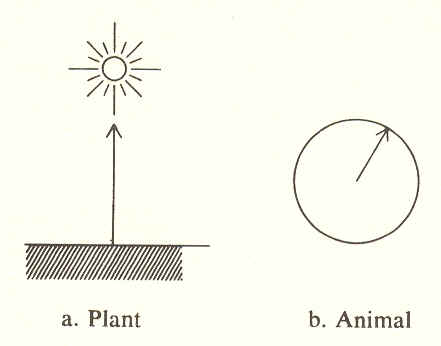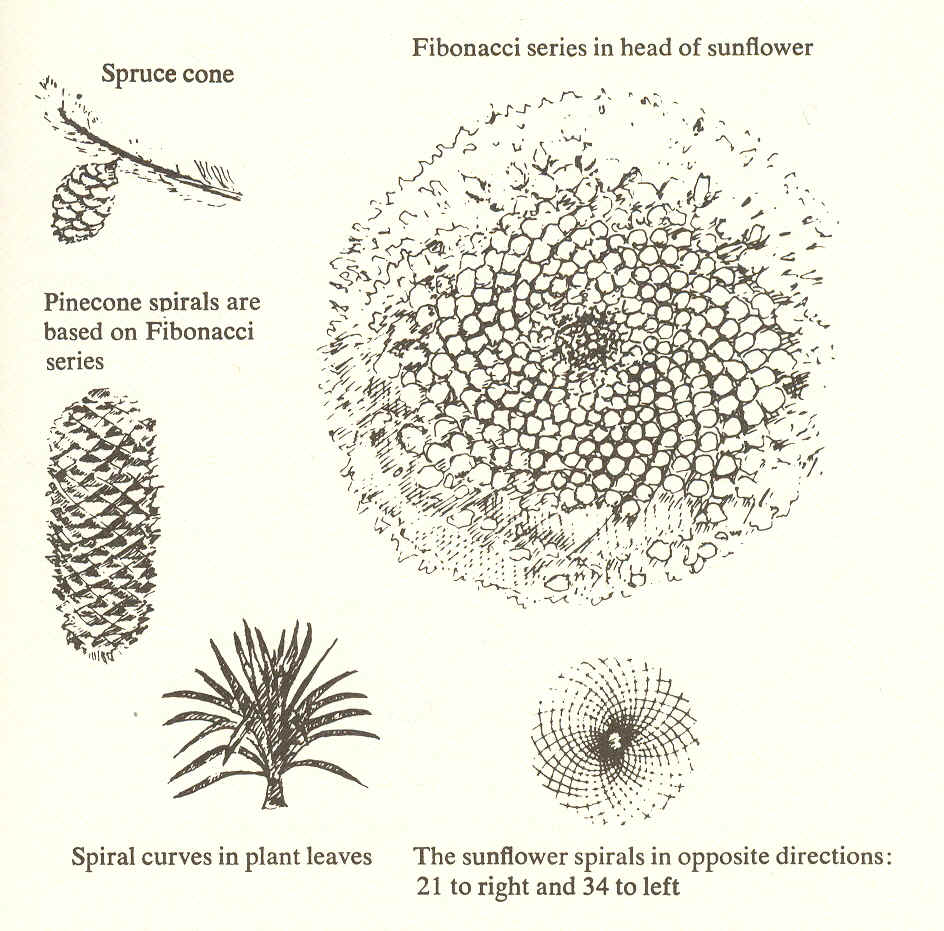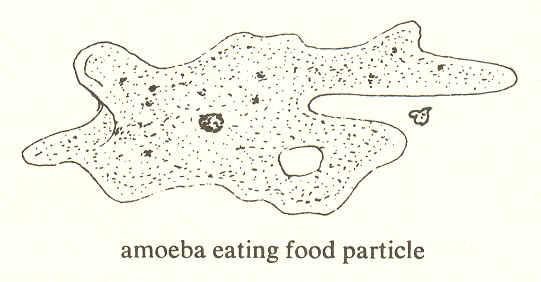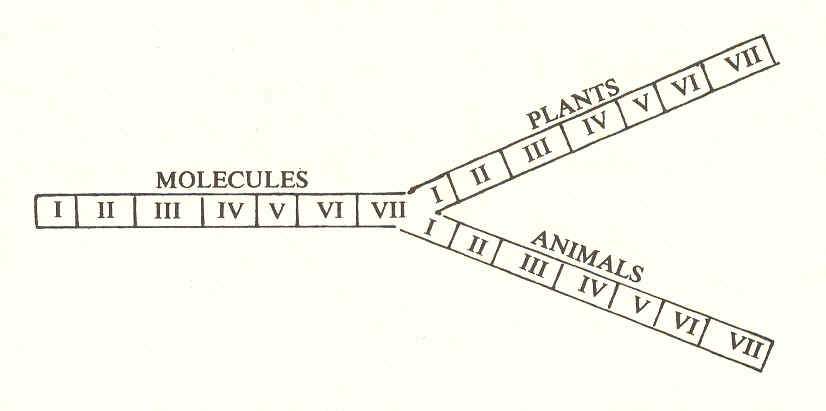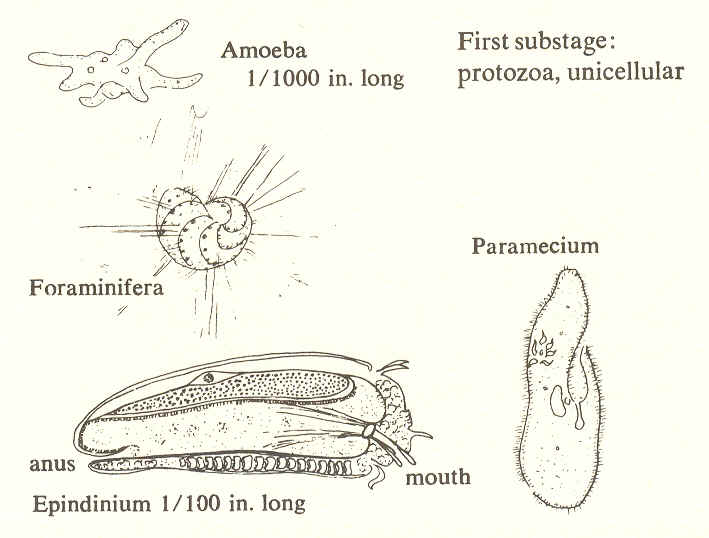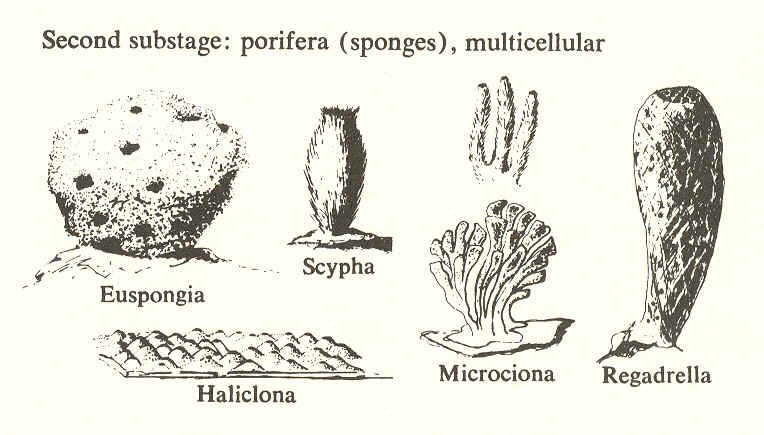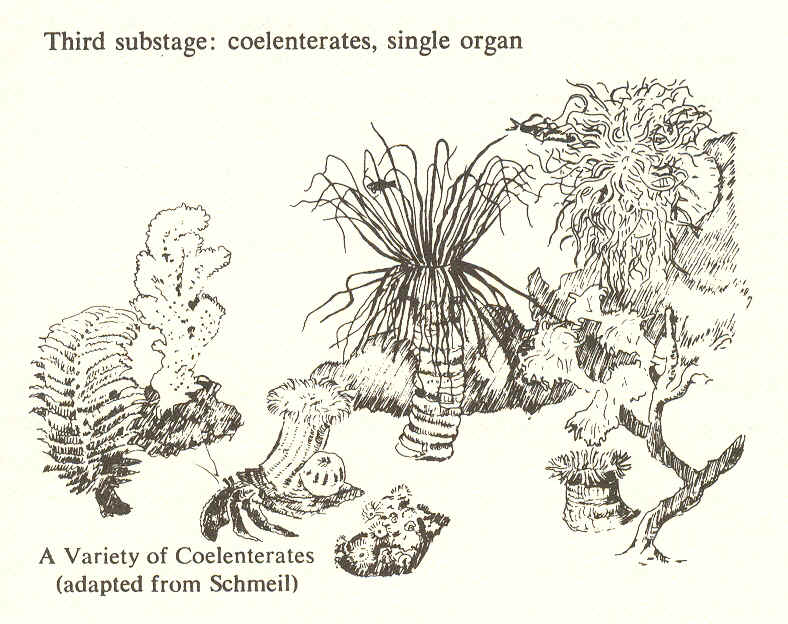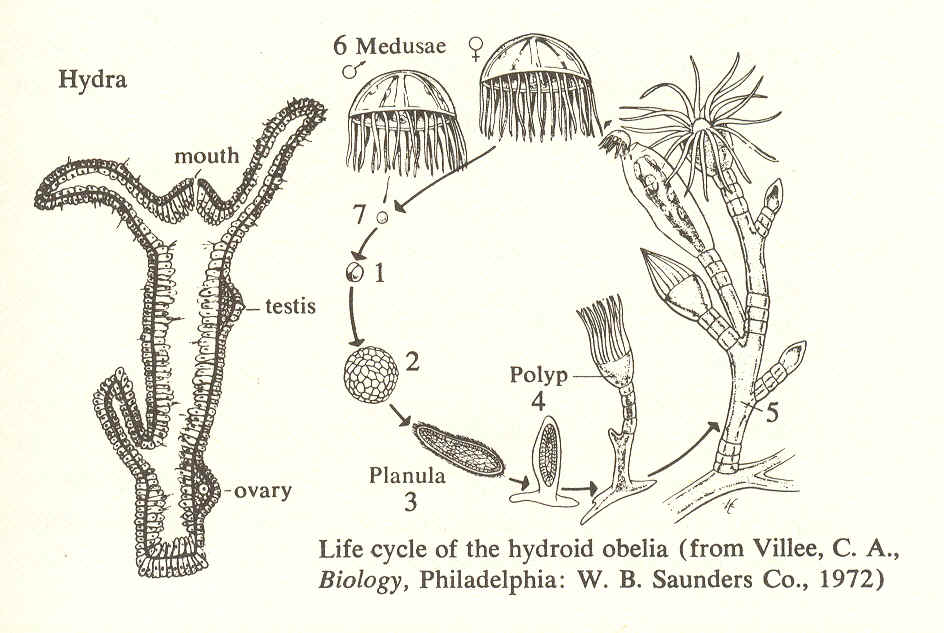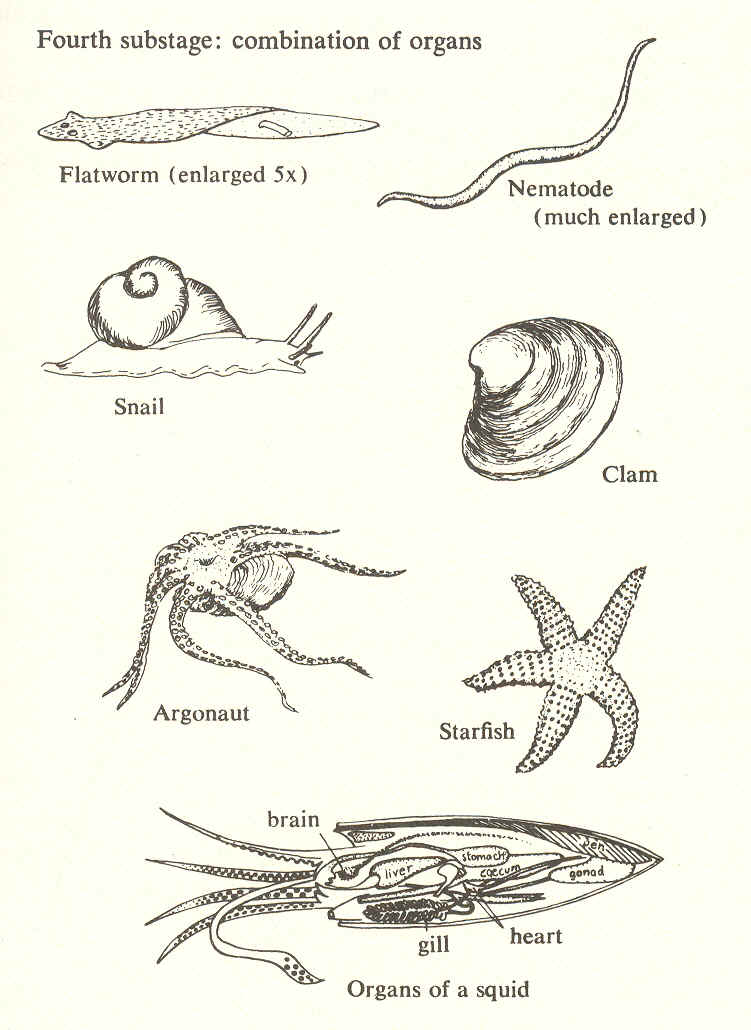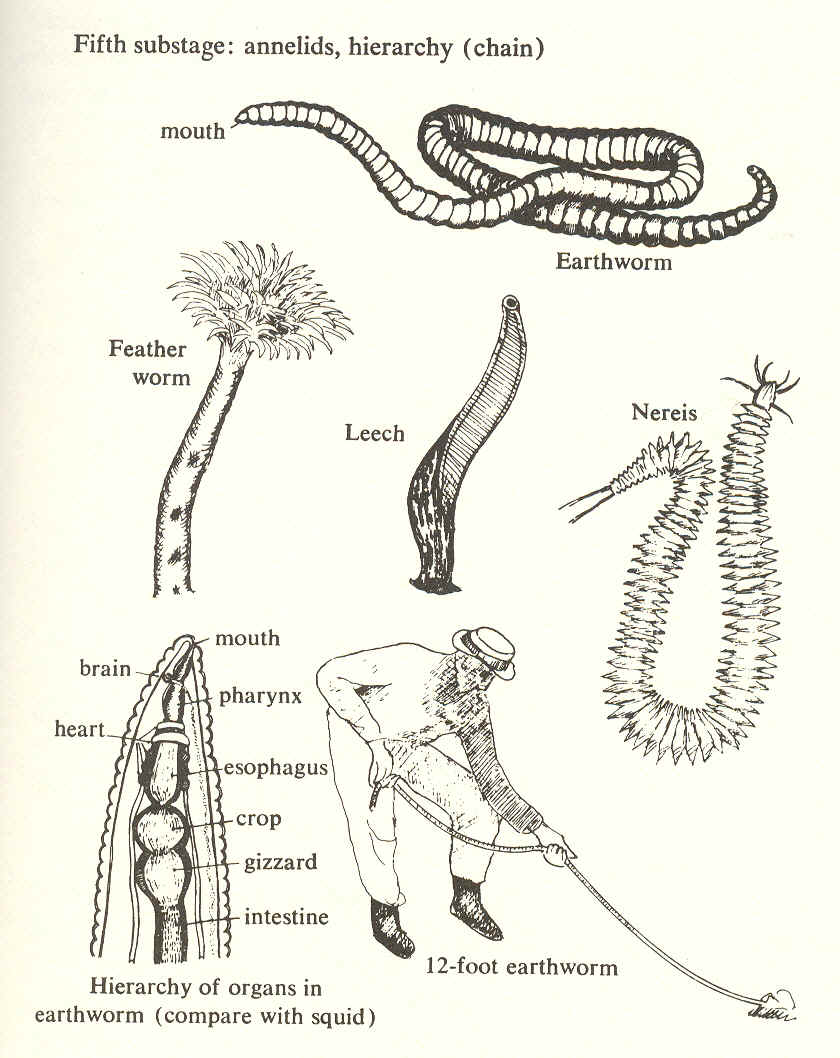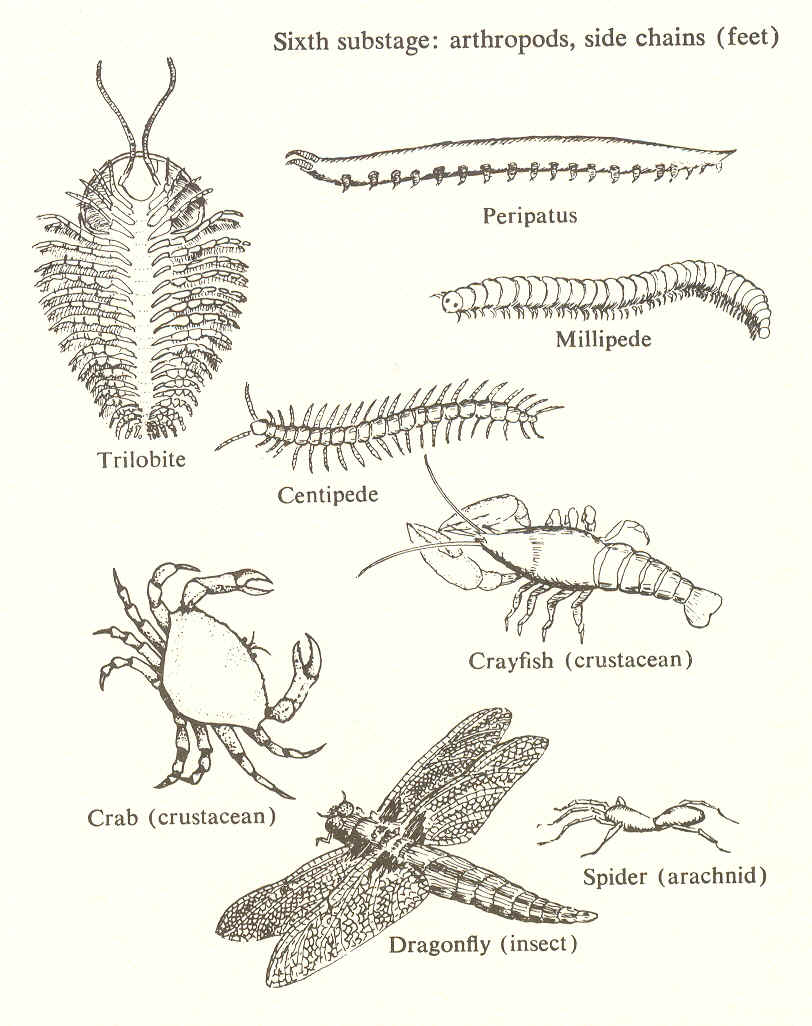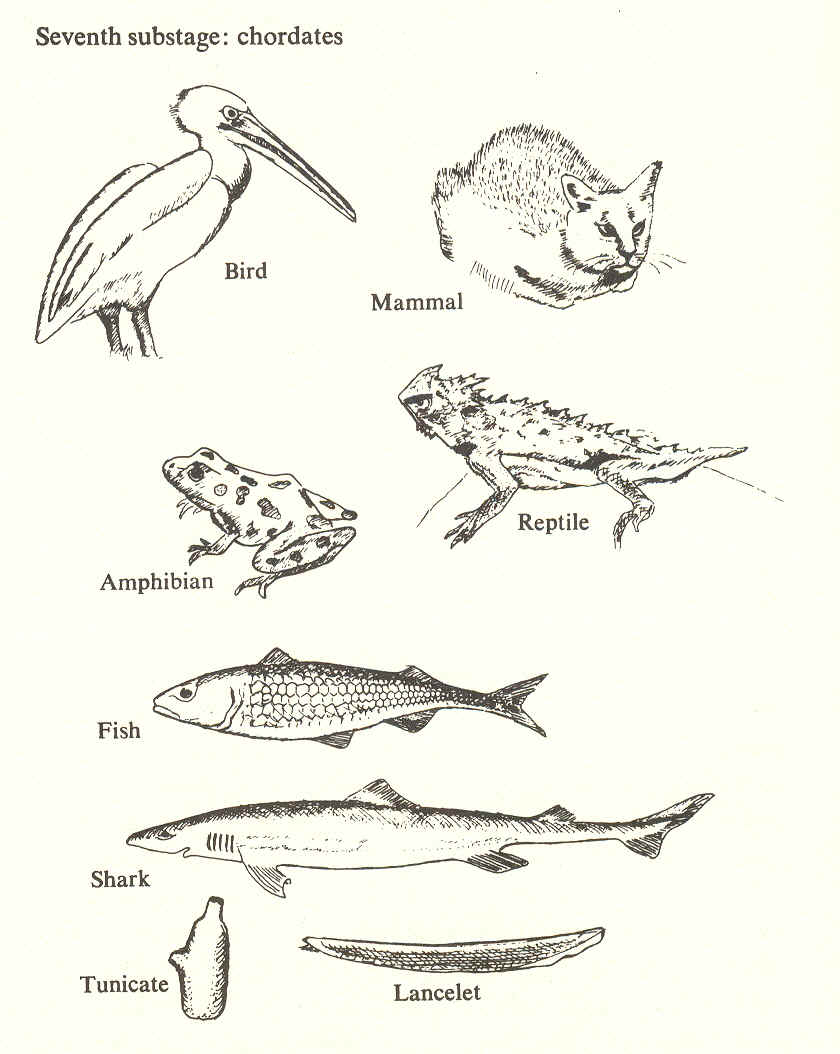*
THE ANIMAL KINGDOM
If the implications of the organization principle in the plant kingdom have stretched our minds, those of the animal kingdom are even more demanding.
Characteristic powers of animals
Voluntary movement
The animal, of course, incorporates the power of organization and growth which it inherits from the plant kingdom. But it develops a new power. The goal of the animal kingdom is mobility. This is not mere motion, nor even self-motion like that of an automobile. It is voluntary motion. The animal moves in quest of food. For the grazing animals the quest is continuous; for predators, occasional but more strenuous. And almost all animals are under constant threat from natural enemies. The animal therefore requires sense awareness to find its food and to warn it of enemy approach. It must evaluate conflicting stimuli and must choose between alternatives. The deer may be motivated by thirst to go to the water hole, but if it scents a lion it will refrain. The animal is perpetually having to decide on a course of action, when and where to move. This is a different order of mechanism from the tropism of plants. In fact, it is not a mechanism at all; it involves value judgments.
This is not true of the "movement" of plants toward light. A potato sending out shoots in a cellar with two windows does not choose one window; it moves toward maximum light and no choice is involved. Even if it be insisted that the animal is moved by the stronger stimulus, this interpretation cannot account for the fact that various kinds of sense data (taste, sight, hearing, smell), as well as internal feelings of hunger, fear, cold, have to be evaluated by a central command, itself not sensory, to lead to action.
We may indicate the difference between the plant tropism and animal motivation by a diagram:
The plant growth is movement toward an indefinitely remote goal, which is in a constant direction, either against gravity or toward light. The animal movement is toward specific and attainable goals - water, food, a mate, shelter - and in any direction. This simple distinction between one dimension (the line) and two dimensions (the "radius" of action) was described in Chapter IV, where we showed that animals and plants, like particles and atoms, exchange freedoms and constraints.
It will be recalled that we were able to show that the uncertainty of position and of velocity (whose product cannot be less than a certain value) is a property common to both nuclear particles and to animals, on level II, and that the uncertainty of contained energy is a property of both atoms and plants on level III.
Flexible shape
This is the deductive basis which prescribes the nature of the powers, quite apart from their development in plants and animals. Emphasis on this deductive principle guides us in further delineation of their character. For example, we have stressed that identity depends on form and appears at level III. Thus the atom has a characteristic form. For example, it is carbon with four valence electrons and it forms tetrahedral crystals. Similarly, the oak has a fixed manner of growth, a characteristic leaf, and so on. The animal, at level II, has a shape even more precise in some respects than the plant because its anatomy involves a precise number of bones and because it has a characteristic covering of scales, fur, or whatever. However, while the plant shape is fixed, the animal's is flexible. In fact, it is due to this that it is able to move.
Let us now relate this change of shape to the exercise of choice, for while clearly choice and voluntary motion have a practical relationship, it is worthwhile to see the theoretical interconnection. Shape in the sense of a fixed outline is two-dimensional. Even a three-dimensional object can be formulated or described by two or more two-dimensional views. Value, by contrast, cannot be formulated, but value can be indicated comparatively on a one-dimensional scale; it is more or less of this or that. (Weight, cost, temperature, for example, are one-dimensional.) We can therefore say the shape of a plant has two constraints and may be formulated.
Such formulation has indeed been proposed. Not only do the curves of plant stems, leaves, and blades of grass follow exponential spirals, but the development of cellular growth in flowers and pine cones proceeds according to an exact formulation, known as the Fibonacci series,* named after the great Italian mathematician, Leonardo of Pisa.
*Examples of the Fibonacci series in nature can be found in Peter S. Stevens, Patterns in Nature, Boston: Little, Brown and Co., 1974.
This formulation states that the terms of the series be such that each term (a) is to its successor (b) as the successor (b) is to their sum (a + b), i.e., a:b = b: (a + b). The ratio a/b, known as the golden mean or
, is equal to
The series of whole numbers 0,1,1,2,3,5,8,13,21,34,55 . . . obeys the rule that each term is equal to the sum of the two preceding terms, and the ratio of any two terms approaches
as a limit.
The sunflower shown in the illustration, freely adapted from an informative article by Martin Gardner in Scientific American (March, 1969, p. 118), is an example of a flower based on two sets of spirals, 21 to the right and 34 to the left, numbers which are successive terms in the Fibonacci series. According to Gardner, giant sunflowers have been developed that go as high as 89 and 144 spirals.
It will be noted that the formula for the golden mean involves the square root of 5. To imply a connection between the number 5 and the fifth principle might incur skepticism, but in Appendix II we show that the joining of n points by lines of equal length is not possible unless
A corollary is that five
points are required to store energy (as in a spring), so that the connection of five-ness with growth is profound.*
*(A tetrahedron, or four points, is required to establish a rigid structure. To store energy in a rigid structure, one more point is required.
Value scale for animals
The value scale of an animal has one dimension and can be measured: Fido likes bones best, dog biscuits less, and so on. This may seem a bit trivial, but it is not, for this statement illustrates the reduced constraint and increased freedom of the animal as against the plant. It also shows that there are two mutually exclusive kinds of meaning: the formal meaning of definition and formulation, and the value meaning that is plus or minus on a scale. The former, level III, is objective, and the latter, level II, is subjective.
The shift that occurs between the plant and animal stages of process is just this shift from a formulated blueprint of growth (the cellular organization as prescribed by DNA) to a value scale (as prescribed by inherited instincts) ranging from positive (pleasure) to negative (pain). The behavior of an army undergoes a similar shift when war is declared. In peacetime the army activity is completely taken up with rules of organization as set forth in manuals-drills, code books, procedures. In time of war the emphasis shifts to defending or capturing a position, to winning a battle, goals which cannot be achieved by a fixed formula and depend on what the enemy does. The target moves and may require counteraction: rules of organization must be transcended.
The animal depends on an outside source for its food supply. Its freedom of motion has been gained by giving up the plant's freedom to manufacture its own energy (photosynthesis). The animal not only must obtain food, but must break it down (digest it) and assimilate it into its own system. This transformation of food dictates the need for the animal's digestive, circulatory, and respiratory systems, consisting of organs whose cooperative interaction enables it to convert ingested food for its own uses. These energy-converting functions are actually the first to evolve. As we will see in studying the substages of the animal kingdom, the first animal organ to develop is the stomach. Next follows a fairly complete organ system. Legs and their musculature come later.
This dependence of the animal on an outside food supply is anticipated in process theory. It correlates to the fixity of mass of the nuclear particle. Once the animal has reached maturity, it maintains a fixed body weight, whereas the plant continues to grow.
Let us list the principal differences between plants and animals:
Plant Animal
Free to create its own energy. Committed to outside source of
energy.
Committed to fixed position. Free to move.
Size continually increases. Size reaches a fixed value.
Shape is determined. Shape is flexible.
Actually, 99.9% percent of the animal's growth occurs in the womb. Growth in the womb is essentially vegetative: the embryo is rooted in the wall of the womb and grows there like a plant. The obelia (see illustration later in this chapter under substage three) is invariably used by biologists to illustrate the life cycle of all animals. After fastening itself to the ocean floor, it grows in plant fashion until it releases mobile forms (jellyfish). This behavior illustrates the manner in which the animal principle builds on the cellular organization principle which is inherited from plants.
Summary
Thus the dynamic syndrome which the animal power exhibits falls under two main heads. The first is voluntary movement with the related ideas of stimulus sensing - appetite, motivation, action, satisfaction, choice, and value. These may be packaged into the single concept animation (from the Latin animus, or "spirit"). The second head comprises feeding, digestion, circulation, change of one kind of organization into another (starch into protein), metamorphosis (change from one shape to another), all of which can be packaged into the single concept transformation.
Both animation and transformation have a common origin, and both follow deductively from the character of level II, whose two degrees of freedom prescribe both motion and the transformation involved in digestion of food. (It is of interest that in mathematics movement is equivalent to a transformation, as in "transformation of coordinates.")
But the abstraction involved in such use of deductive principles is demanding, and it is rewarding to find that in the simplest of animals, the amoeba, the principles of motion and digestion are fused into one or, more correctly put, are seen as they are before the two functions differentiate.
This is the animal power. Stimulus, motion, ingestion, and transformation are potentially present here at the first substage of the kingdom, before the multicellular creature has differentiated digestion, circulation, respiration, sensing, motion, and self-limitation into separate functions. It is as different from the vegetable principle of organization, growth, and reproduction as a principle can be, even though the animal in its cellular or vegetative organization incorporates the growth and reproductive powers of the plant kingdom.
A question of sequence: a-a-b pattern
But a disconcerting fact emerges, one that challenges the whole notion of sequential development. This is that primitive animals are very similar to primitive plants. Both are unicellular and appear to stem from the same origins.
A diagram would show molecules going through their whole sequential development to DNA, which becomes the common basis for both plants and animals.
One cannot say that plants and animals form a sequence when both start from the same point, the unicellular protist.*
*Protist is the biologist's name for the hypothetical progenitor of plant and animal cells.
This objection, which apparently denies the validity of a chain of evolutionary forms, actually turns out to provide one of the most important features of process theory. This is the a-a-b pattern, which I have described in Chapter VI in regard to the periodic table of the elements.
Plants, to be sure, develop from the most complicated molecules. But if we go back further still and ask "On what sort of atoms are molecules based?" we find that 99 percent of important molecules are composed of the simplest atoms. All carbohydrates and fats are composed only of hydrogen, carbon, and oxygen, elements from the first two rows of the atomic table. If we add nitrogen and an occasional sulphur, we can construct proteins; and if we add phosphorus, the complex DNA. So that by far the greater portion of complex molecules are made of the simplest atoms. And complex molecules of radium atoms, or even of sixth-row atoms, scarcely if ever occur.
So there is a precedent for the branching of animals and vegetables; the molecules also branch:
To complete the pattern, we find that all atoms except hydrogen develop from the helium nucleus at the end of the previous kingdom (according to the best tentative division of the nuclear kingdom and we find that the proton is based on the high-energy photon a beginning of the light kingdom.
So we have a regularity and hence a rule which may be formulated
Odd kingdoms develop from the advanced end of the previous kingdom.
Even kingdoms develop from the beginning of the previous,
In other words, even kingdoms repeat, odd ones innovate.
This pattern is very explicit in the substages of the atom (covered in Chapter VI).
Note that each type of shell repeats before a new type of shell is added. Because of this repetition, the four types of subshell, having two, six, ten, or fourteen electrons, suffice for seven rows of atoms.
But why does process use this a-a-b pattern for its development?
I believe the answer is that such repetition is required in order process may incorporate as it advances. It progresses by an alternation of innovation and recapitulation. In music we encounter a similar development: a theme is repeated before new and more complete development is introduced.*
*This cumulative development is discussed in reference to art and artifacts by George Kubler in The Shape of Time, New Haven: Yale University Press 1962.
Needles and pins
Needles and pins
When a man marries
His trouble begins.
It is also a device used in fairy tales, where it is always the third son who overcomes the evil magician and marries the princess. If it be said that this is a psychological quirk, then we have to say that nature is psychological. Certainly, process requires memory of what it has been through, and recapitulation achieves this.
The a-a-b pattern, then, is intrinsic to process; we will find that it holds even in the substages, and that it provides a further theoretical constraint on the properties of the stages, whose nature flows from these principles.
Animal substages
First substage
The first substage of the animal kingdom, as with plants, is unicellular. Amoebae and protozoa are examples. Both are capable of motion and of digesting food. It is interesting how the unicellular creatures anticipate the later development: thus, a foraminifer, despite the fact it is only one cell, makes a spiral shell quite similar to that of snails and cephalopods which are multicellular and billions of times heavier. The epidinium, 1/100 of an inch long, has a rudimentary skeleton, a mouth, stomach, and anus, anticipating the highly evolved vertebrates. Thus the first substage in its anticipation of later developments illustrates the key word "potential" of the first substage.
Second substage
Binding power produces the first multicellular animals, sponges; mobility is sacrificed in the interest of size. There is some cell differentiation, such as holdfast cells, but no organs or tissue differentiation.
It could be objected that sponges are less mobile than amoebae and hence do not represent an advance of the mobility power. But we must realize that the principle of the fall still applies to the substage: means must be developed. The motion of the unicellular animal, like its size, is microscopic. To get further, the animal must, like the plant, invest in greater bulk. The sponge also recapitulates the plant in that it is glued to the ocean floor.
Third substage
Plants at this substage, as we have noted, develop identity in terms of reproduction. They differentiate the embryo from the rest of the plant. What does a mass of animal cells do to obtain an identity? It forms itself into a hollow chamber, or stomach, with a mouth surrounded by sensitive feelers. On the approach of a small fish or other food, the feelers seize it, draw it into the stomach, and digest it. Such is the coelenterate ("coer' = hollow, "enterate" = stomach), the first animal with an organ. The coelenterates include the sea anemone, which for a great part of its life cycle is stuck to the ocean floor and resembles a flower. (This could be evidence of a recapitulation of the previous kingdom.)
Another coelenterate, the hydroid, which also looks like a plant, produces buds which break off and become mobile jellyfish that use the same hollow organ to propel themselves. Its life cycle, viewed in terms of process theory, falls into seven stages: (1) starts as one cell; (2) becomes multicellular; (3) acquires a shape (identity); (4) fastens to the ocean floor; (5) grows in plant-like fashion; (6) flowers break off into mobile jellyfish; (7) fertilization.
Fourth substage
Up to this point our subdivisions correlate with the divisions made by zoologists: (1) unicellular, (2) multicellular, and (3) coelenterates.
But in our scheme the fourth substage, defined as "combination of organs," includes animals which zoologists now divide into a number of phyla.
The classification of animals by zoologists into phyla, which is the broadest division of the animal kingdom, is based on morphology (structure). The classification used in the present theory is based on the degree of organization. On the whole, the two classifications agree well. This is because the classification by organization, i.e., one-cell, multicell, etc., inevitably creates morphological distinctions. However, the reverse is not true; morphological differences do not necessarily imply a difference in level of organization. Thus there are a number of animal types which we list as fourth-substage (many organs), but which zoologists divide into different phyla:
Ctenophora (Possible third-substage)
Platyhelminthes Flatworm
Nemathelminthes Roundworm
Rotifera Partially extinct
Bryozoa "
Brachiopoda "
Echinodermata Starfish
Mollusca Shellfish (including squid)
It would be difficult to list the above animal types in order of their degree of organization. Some are an advance in one respect, others in another; none has made the organizational leap that distinguishes the annelid or earthworm: that of arranging organs into a hierarchy, with a head at the top.
The division we make, on the basis of organization, puts all the above in the same substage - combination of organs. It thus emphasizes combination, the key word of the fourth, and it also meets the a-a-b requirement since the innovation of the third substage, the organ, is here repeated.
Admittedly, there is a great variety of creature here, but the variety per se does not bring a new level of organization, which is what the substages represent.
An interesting feature of this substage, which echoes the combination theme in a different way, is that most of these creatures are of two sexes which mate, in contrast to the third-stage coelenterates, which reproduce by budding, and to the fifth substage, which are hermaphrodite.
Fifth substage
The fourth-substage animals develop all the organs which are required; how is organization to do more? It cannot improve the organs themselves, but it can make them more effective by providing a chain. The fifth principle or power is chain-like: a chain of molecular units as in the polymers, a chain of bamboo-like segments as in the calamites (fifth-substage plants), a chain of cells or of generations throughout the plant kingdom. Here we can rejoin the zoologists, and use the classification they provide. We can place at the fifth substage the first animals which consist of a chain of segments or rings, known as annelids.
The annelids, which include the common earthworm, involve a new principle, known as metamerization, which persists in all higher kingdoms. (The vertebrates are metameric.) Metamerization involves the arrangement of organs in sequence, with the head at the top and close to the mouth to deal with new situations; what was the stomach now becomes a long passageway with organs of digestion and assimilation, having semiautomatic jobs which do not require choice or attention, located at a distance from the head.
Annelids thus meet the chain requirement by creating a hierarchy of organs. Their mobility, based on stretching and contracting, is also linear in nature.
We might also note that of the two basic contributions to evolution, transformation and mobility, the power to transform (i.e., obtaining energy by digestion of food and its conversion into new forms) evolves first, on the downward branch of the arc. The power to move, though present in all animals, begins its development at the fourth substage and continues through the upward branch. Here with the annelids it makes a great leap; by providing articulation it lays the basis for the next stage, arthropods.
Sixth substage
It is impossible to do justice to the variety of life by listing it under levels of organization, especially when we come to arthropods, which include crustaceans, spiders, and some 600,000 species of insects. On the other hand, there is something wonderful about being able to express the key principles by which so much variety is generated. Even more so when the very names chosen by zoologists confirm the stages of process chosen. Arthropods, which means "jointed feet," are the first animals with legs. What are legs? They are segmented side chains attached to a segmented trunk, an echo of the sixth-substage molecules, functional polymers, which are also chains with side chains (and remember too that they are chemicals that move).
Referring to the illustration, we can appreciate that the examples chosen can hardly convey the scope of this great phylum. But one thing is evident: legs, or segmented appendages, are the theme throughout. Such emphasis on legs must have to do with their importance for mobility. While millipedes have less than one thousand legs and centipedes less than one hundred (forty-four in the one shown), it is interesting that crustaceans (decapods) have ten legs, spiders eight, and insects six. Moreover, with the exception of the peripatus, all, including the trilobite, have legs of seven segments. (So do we.)
The examples shown are the main subdivisions or classes of the phylum Arthropoda (Decapoda are represented by two examples).
Looking back over the animal kingdom, note how the a-a-b pattern has held. The first creatures were unicellular, the second multicellular; the third had one organ, the fourth many organs; the fifth introduced segmentation, the sixth added segmented legs. Each odd stage introduces a new development; each even stage repeats and extends it.
Seventh substage
The seventh starts over with a new principle, embodied in the Chordata.
The new principle, suggested by the name of this phylum, the last of the animal kingdom, is a central nervous system (notochord) extending along the animal's back and (except for certain primitive marine forms) encased in a protective bony spine. Other important distinctive features are present, but rather than recite these I would ask the reader to look over the classes of this phylum, from lancelets to mammals, and make his own observations.
So far as a knowledge of zoology goes, I can only repeat what the textbooks say, which is interesting and important. However, since the origin of the chordates is unknown, it might be just as well to look at the creatures rather than the textbook. They include primitive spineless subphyla (of which only the lancelet is shown) and all the vertebrates.
Note that although arthropods are mostly terrestrial, the chordates start in the sea. They begin over again with regard to legs too, and when they do sprout legs, the number is four, a number not in the repertoire of the arthropods despite their preoccupation with legs.
Another thing that interests me is the eye.* All have eyes, not the compound eyes of the insect, but a real eyeball. You couldn't look a bee in the eye, because he has a thousand eyes. I had not noticed the eye until I made the sketches, but once I had done so, the eye struck me as a motif as important as is the leg of the arthropods in the previous substage.
*The retina and the optic nerve of the chordate eye actually grow out from the forebrain. A pair of bulbs or stalks develops and expands, each to form a hollow called the optic cup. These stalks project until they contact the outer layer of the embryo. The lens of the eye is formed from this outer layer.
The control function
A conspicuous feature of the chordates' nervous system is that it is dual: there is the so-called autonomic system, itself divided into sympathetic and parasympathetic, and the voluntary system. These systems have different functions: the former controls blood circulation, bowel movement, and other autonomic functions, the latter the sensory and motor functions which have to do with volitional movement. The two functions were formerly regarded as separate, and it was assumed that the voluntary could not take over control of circulation, heartbeat, etc. But recent investigation has shown that, with the aid of instrumentation which tells the subject when, for example, there is more blood in the hand, it is possible to learn to increase or decrease the circulation to that member. These experiments show that the voluntary nervous system can take over the autonomic functions if an effort is made to that end. It has been found possible to train mammals (rats) in this manner. Training in such control has long been a part of Yoga techniques, which I will not go into here. What is important is that without such an extra function of control, it is difficult to explain the voluntary control of autonomous functions. The occurrence of conflict between purpose (or "spirit") and appetite could not be accounted for otherwise.
This dualism answers a number of questions that otherwise are unexplained. More significantly, it is in keeping with what would be expected on the basis of process theory. The seventh substage, like the seventh stage, must introduce a new principle. The principle must be one that has a control function. And it is appropriate that it embrace control of the organism itself, as well as control of the environment.
The voluntary nervous system can, in fact, be thought of as an inner eye, an agency of self-consciousness which cannot be explained in terms of the purely sensory awareness which would arise from the autonomic nervous system alone. As noted earlier, the eye is a conspicuous feature of all vertebrates, and its morphological and functional basis as the upper end of the nerve cord, and hence its link with the brain, adds a convincing argument that the nerve cord has its origins very early in the evolutionary chain and is not derived from annelid, and certainly not from arthropod, ancestors.
Recapitulation
The exuberance and variety of the animal kingdom may have distracted the reader from the main reason for the survey, so we should recall that our purpose was to illustrate grid technique, which is based on the assumption that each stage of process is itself a process and that the character of each substage is similar to the corresponding stage, and vice versa.
We have seen how the animal evolves in stages or levels of organization. It begins as a single microscopic cell, very much alive but with a very small radius of action. Its next step is to gain size by becoming multicellular. Size attained, it acquires identity through creation of a stomach, then other, coordinating organs: heart, liver, intestine, etc. Its next step is metamerization: the body laid out in a chain of segments, as in the earthworm, with the organs in sequence, like an assembly line. It is now ready for the innovation that makes true mobility possible, the articulated foot (arthropod). (Certainly if man's greatest invention was the wheel, nature's was the foot!) Finally, the whole organism is coordinated under the central nervous system of the Chordata. Note that it is just this kind of evolution, the advance to more complex form, that is not explained by survival. The leaps to higher forms of organization are inherent in all process, atoms and molecules as well as living creatures.
